How to Get Rid of Muffin Top in 30 Days
Affiliate Disclosure: I receive a small commission for purchases made via affiliate links.
I've mentioned my super-easy DIY vitamin C serum a few times before on social media, and some of you have been asking me for the recipe… but I've been so distracted with other things I never got around to posting it until now. I'm sorry! Please forgive me. I hope the results make up for my tardiness!
Here's the video (you may need to disable AdBlock to see it) – scroll down for the recipe. Click here to watch on YouTube.
What Does Vitamin C Do in Skincare?
Vitamin C is a superstar anti-aging ingredient in skincare. It tackles anti-aging on lots of levels:
- Can increase collagen, which plumps up skin and decreases wrinkles
- Fades hyperpigmentation (brown marks like acne scars and sun spots)
- Acts as an antioxidant, protecting against free radical damage from UV, pollution and natural aging
Who wouldn't want this, right? It does a bit of everything!
Related post: Antioxidants in Skincare: What Do They Do?
The Problem With Vitamin C
The big problem with using vitamin C in products is that L-ascorbic acid is very unstable in water-based products. It turns into yellow dehydroascorbic acid (DHA or DHAA) and other products very quickly: at pH 3.52 and 25 °C in amber glass, 50% is gone in a week. Luckily, DHA can convert back to L-ascorbic acid in your skin, and there's no evidence that it's bad for your skin (there's actually a product with an accompanying non-peer-reviewed study that actually uses it as a way of getting vitamin C into your skin more easily). But there's not a lot of evidence that it's good either, and it degrades further into products that can't be turned back into L-ascorbic acid.
Related post: Why Vitamin C Can Stain Your Skin (and How to Avoid It!)
L-Ascorbic acid can be stabilised by combining it with vitamin E and ferulic acid (plus it makes it work better). This is the approach used in serums from SkinCeuticals, Paula's Choice, Timeless, Cosmetic Skin Solutions and Ausceuticals, However, if you want to DIY with this combo, it not only requires buying vitamin E and ferulic acid, but you'll also have to get an emulsifier because vitamin E doesn't play nicely with water.
And if you've gone to the trouble of mixing all that, you'll also want a preservative to suppress bacterial growth so it'll last longer and you won't have to remake it any time soon. The price of all these ingredients adds up quickly, and if you've done any DIY before, you'll know that you'll end up with barely-used bottles that will go off before you finish them.
L-Ascorbic acid can also be stabilised by altering its chemical structure. Some derivatives of LAA include magnesium ascorbyl phosphate (MAP), and ascorbyl tetraisopalmitate (ATIP)/tetrahexyldecyl ascorbate (THDA). However, these are expensive compared to LAA, and they need to be converted back into LAA to work as effectively.
Related post: Mythbusting: Are Vitamin C Serums Bad for You?
The Solution: DIY Vitamin C Serum
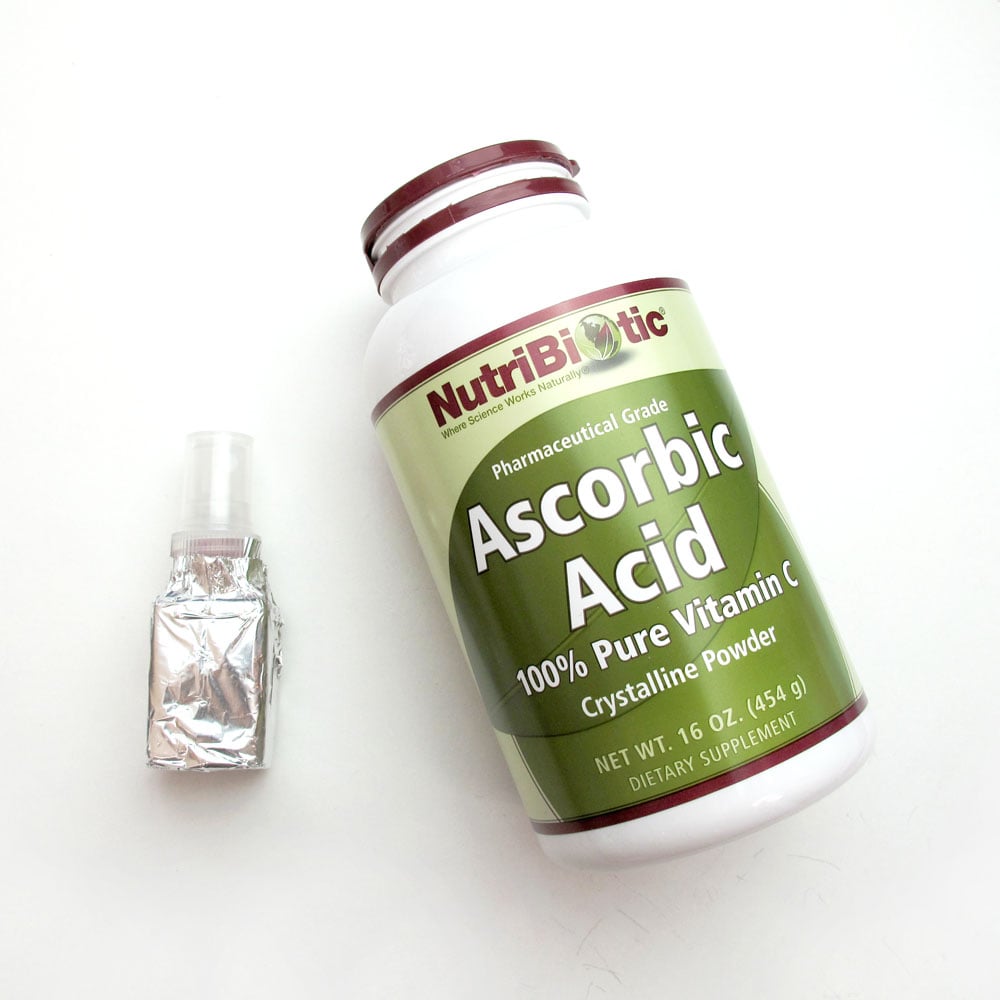
All these issues can be solved by using a DIY vitamin C serum that you remake every week or so. I generally find DIY a bit of a pain – the minimum orders of the ingredients are too large for me to use up personally so I end up spending way more money than using a pre-made product, and there's the horrible feeling of wastage when you chuck out expired, barely-used ingredients.
There's also the time required to cook up your product, the failed batches, and the dreaded washing-up afterwards. But it's hard to find a downside to this DIY serum:
- All the ingredients and materials are easy to get and inexpensive
- It takes about 5 minutes to make with no special equipment required
- It can bemore effective than a store-bought product – you don't have to deal with delivery times and distribution networks and having your vitamin C sit on a store shelf slowly degrading for an unknown period of time
- You can easily adjust the amount of vitamin C in your serum – add more LAA to ramp up the effectiveness, or use less LAA to decrease irritation
- It's cheap enough that I don't feel bad spraying it all over my face and chest and body
For an effective vitamin C serum, you need 5-20% LAA at a pH less than 3.5. Above 20%, the effectiveness of LAA doesn't increase but the side effects (mostly irritation) do.
Easy DIY Vitamin C Serum Recipe
Ingredients and Materials
Here's what you need for a basic serum:
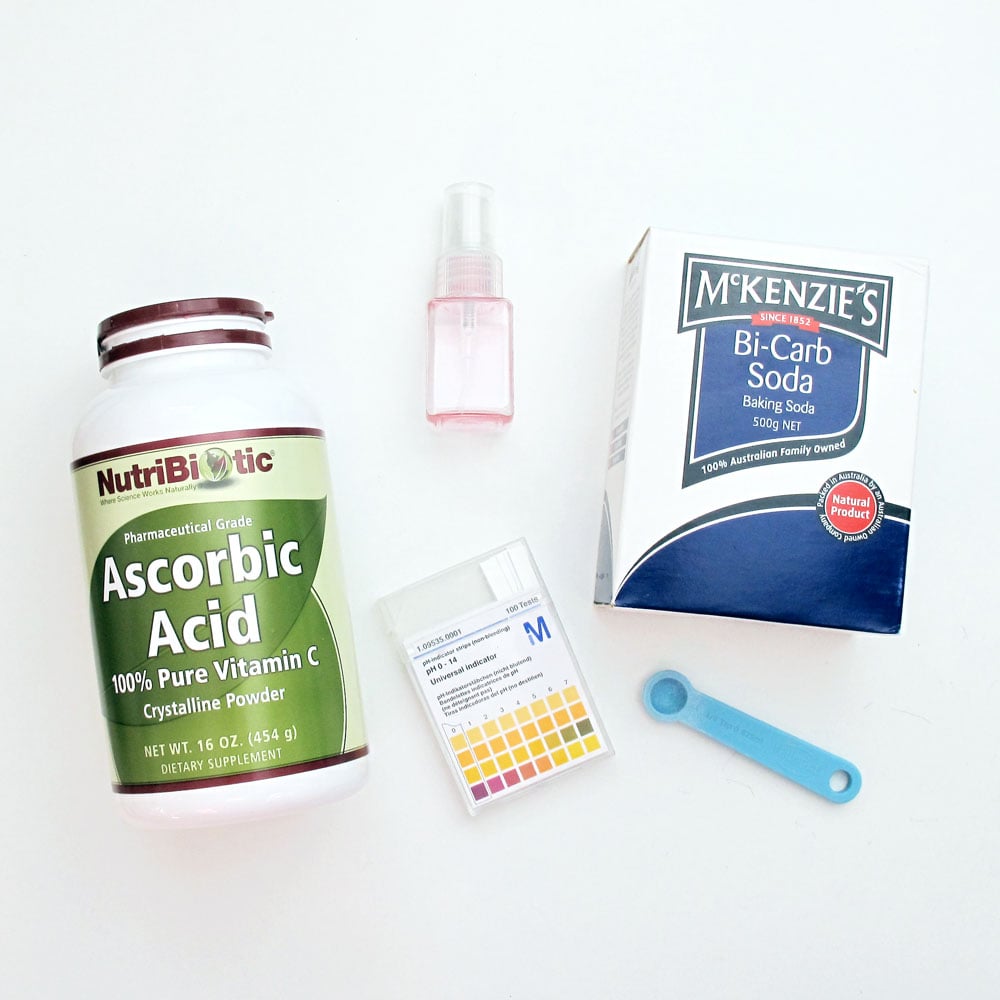
- L-Ascorbic acid powder
As a dry solid, LAA is reasonably stable and cheap. You can find this at most supplement stores, or you can order it off iHerb like I did (Amazon has this brand too). Some powders apparently don't dissolve very well, but I didn't have any issues with NutriBiotic. I don't recommend using crushed tablets because it ends up more expensive, plus you end up with random bits of fillers on your face.
- Distilled water
Metal ions in your water can speed up the rate of LAA decomposition. You can get distilled or deionised water at the supermarket for a few dollars. You can also use water filtered through a very fine filter that can remove metal ions (a nanofilter). Alternatively, you can use tap water and just remake your serum more frequently.
- Baking soda
The pH of ascorbic acid alone in water is going to be too low (too acidic), which will cause unnecessary irritation. Baking soda is alkaline, so we can use it to adjust the pH back up, closer to skin pH.
- pH strips
To see what the pH is. It doesn't have to be exact, so any indicator strips will do – I prefer the four-square indicator strips so I don't second-guess my colour matching abilities. You can get similar ones here.
- 1/4 teaspoon measuring spoon
1/4 teaspoon is 1.23 or 1.48 mL (depending if it's US or Imperial), which translates to ~1 g ascorbic acid. Ideally weighing it is much more accurate, but for this quick-and-dirty recipe volumetric measurement will do.
- A suitable container
You want an airtight(-ish) clean container. It doesn't have to be truly airtight since you'll be remaking this often. I bought my bottle from Daiso, but you can get similar ones in the travel or cosmetics section of the supermarket (Amazon's cheapest is here).
- Aluminium foil
Enough to wrap around your container to lightproof it. Even if your container has coloured glass, this is a good idea!
Directions
1. Work out how much serum you can fit into your container in millilitres. If it's new or a product container you're reusing, it should say on the packaging. If you can't work it out, you can either check how many teaspoons of water fit in it using a teaspoon measure, or eyeball it against similar containers you own.
2. Calculate how many grams of LAA you need.
- For a 5% serum, multiply the volume of your container in mL by 0.05 to get the LAA required in grams. (grams = mL x 0.05)
- For a 10% serum, multiply the volume of your container by 0.1 to get the LAA required in grams. (grams = mL x 0.1)
- For a 20% serum, multiply the volume of your container by 0.2 to get the LAA required in grams. (grams = mL x 0.2)
For example, I'm making 20 mL of a 10% vitamin C serum: grams = 20 x 0.1 = 2 grams LAA.
3. Clean your container. Wash it out thoroughly then rinse with alcohol (methylated spirits) and let dry, then rinse it out a few times with your distilled water. If you don't have time for this, you can skip the alcohol but it could lead to it going off faster (if you remake it weekly it shouldn't be a problem).
4. Put the appropriate amount of LAA into your container. If you have scales capable of weighing to the nearest 0.1 g you can use that. A faster and reasonably accurate method is to use your 1/4 teaspoon measure and assume that a level teaspoon is approximately 1.5 g. It doesn't have to be super exact – your skin isn't going to respond significantly differently to 5% ascorbic acid vs 7% ascorbic acid.
(If you're super diligent and own scales, you can calibrate your teaspoon and your particular ascorbic acid powder by weighing out a flat teaspoon yourself, then using the faster teaspoon measure for future batches.)
5. Dissolve the LAA powder. Add about half the distilled water, put the lid on and give it a healthy shake until all the LAA powder has dissolved. If you fill the bottle all the way to the top, it's harder to shake.
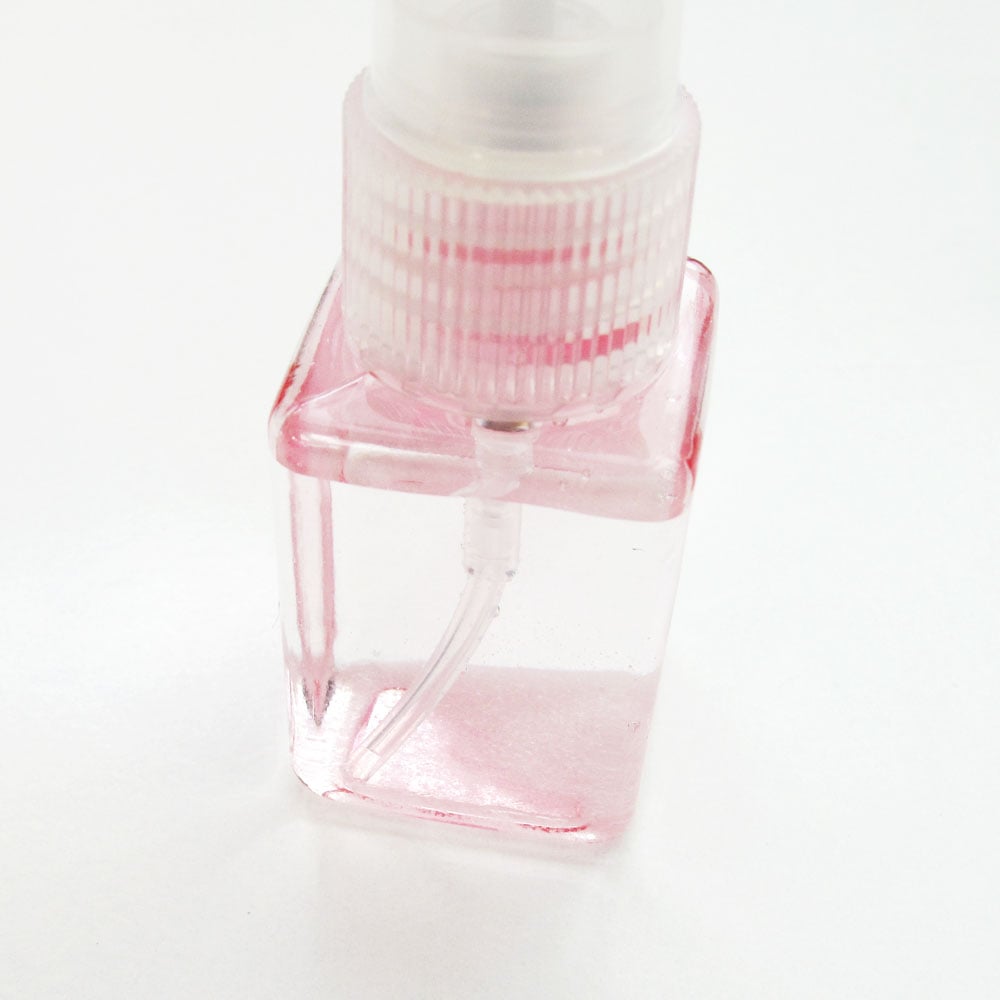
6. Add the rest of the water. Shake a few times until it's mixed.
7. pH adjustment. Put a drop of serum on your pH strip to check the pH (you can dip the strip in if you want, but you might end up with ugly floaty bits in your serum). It's probably going to be too low. Add baking soda a tiny bit at a time, testing the pH as you go, until the pH is between 3 and 4.
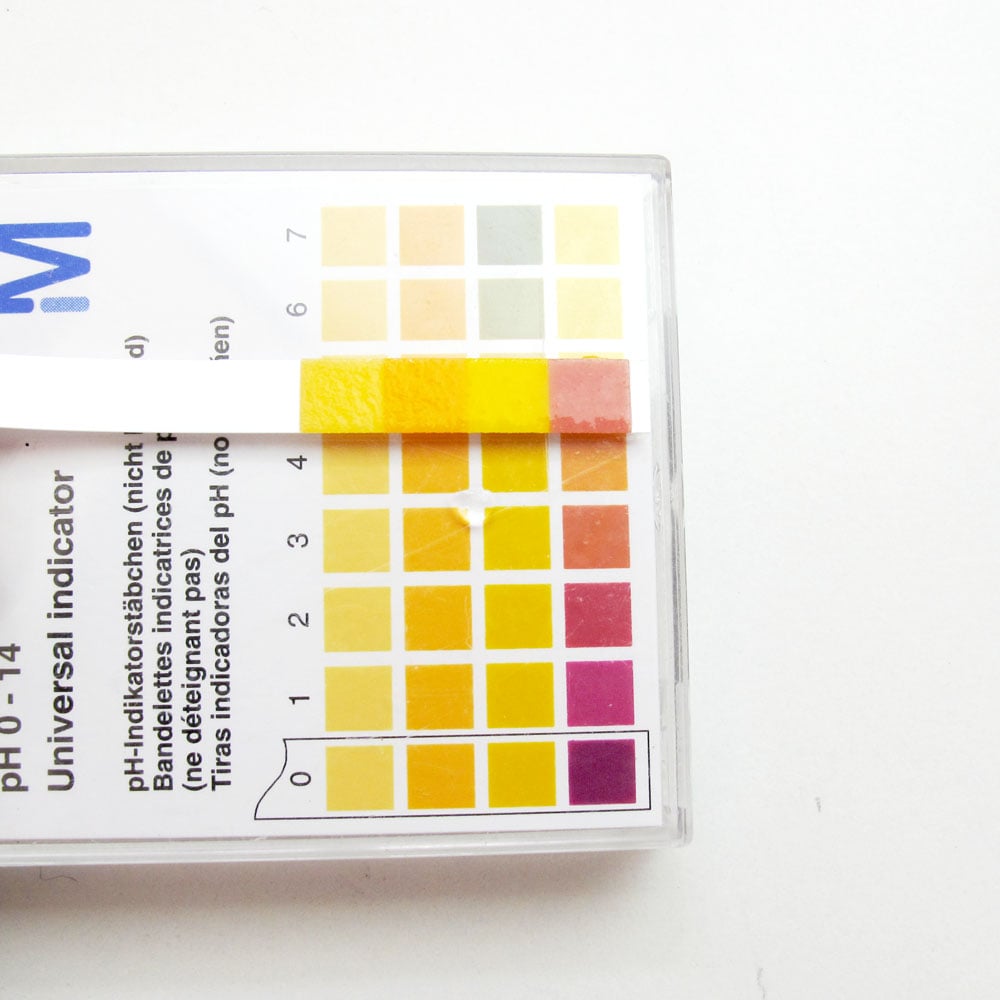
For 20 mL of my 10% serum, I found that I needed about 3 rice grains' worth of baking soda to get to pH ~3.5.
8. Wrap the bottle in foil. This is a little trick I picked up in the lab during my PhD. It's the easiest and cheapest way to protect a light-sensitive substance. Light can still get in at the top so if you want you can make your bottle a little foil hat, but I find that it doesn't help over the short period especially if I keep it in the dark.
If you want to get fancy, you can also get light-protected packaging, but I'm a basic bitch so I'm happy with foil. Even if you have coloured glass, I'd recommend adding foil armour.
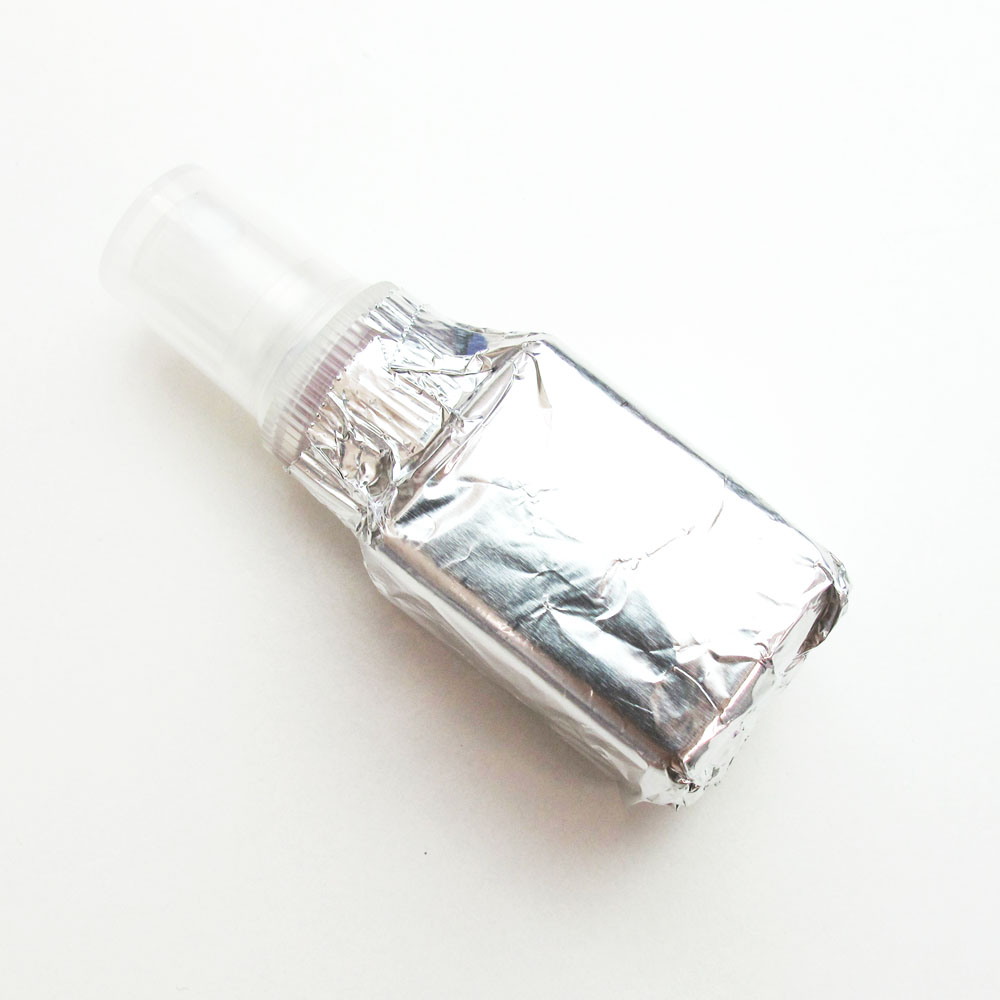
How long does this DIY vitamin C serum last?
With light protection, I've found that it gets slightly yellow after a week, and noticeably yellow after 2 weeks, so I think 2 weeks is the upper limit here. The pH is low enough that most bacteria won't be able to thrive so microbial growth isn't a big worry, especially when you won't be keeping the serum for very long.
There you go! You can get fancier if you're feeling less lazy (e.g. adding glycerin to make it humectant as well, combining it with AHA), but this is an effective, inexpensive vitamin C serum that's easy enough to make that even lazy skincare addicts like me can remake it regularly.
Once you're used to the process, I reckon you'll be able to make it in under 5 minutes! (I'm curious about how quickly this can be done, so if you decide to time yourself please let me know! I'll update with the time I take for my next batch.)
Questions about this recipe (updated Feb 2020)
In the few years I've had this recipe up, I've had a bunch of questions about whether or not it'll really work, if it's dangerous etc. – so here they are in the one spot.
Why doesn't DIY vitamin C serum need preservatives?
In DIY communities, the usual mantra is that all water-based products need added preservatives… which isn't quite accurate. Low pH, or high hydrogen ion concentrations, is in itself a preservative. For example, vinegar is self-preserving, and can be used to preserve other foods.
In general, products with a pH below 4 or above 10 (i.e. 1000 times more acidic or basic than water) won't need a preservative.
Of course, extreme pH doesn't work for a lot of formulations like emulsions. But this only has an aqueous phase (it's a homogeneous solution).
There's also the fact we're only keeping this product for a few weeks before throwing it out, so the low pH will be sufficient to keep it preserved for that length of time.
Won't the L-ascorbic acid crystallise on your skin and not work?
I've seen some people say that L-ascorbic acid from this serum will crystallise on your skin and not penetrate because there aren't any other solvents in this product (e.g. glycols) to keep it dissolved.
However, there's evidence that products containing solid L-ascorbic acid will work fine on skin. For example, this study found increased collagen and cytokeratin when a water-free product containing microfine ascorbic acid crystals was applied to skin samples. It's likely that water evaporating from your skin (through TEWL) will gradually dissolve any ascorbic acid on your skin and allow it to absorb.
Isn't it dangerous to measure by volume using a teaspoon instead of weighing the ascorbic acid properly?
It's definitely better to weigh out the ascorbic acid. However, there's a pretty big leeway in how much ascorbic acid can be used in vitamin C serums, so if you aim for a 10% serum, you can be out by a factor of 2 each way and still end up at 5-20%.
Plus there's also the fact that the main risk with this serum is low pH – however, we adjust and test the pH after the ascorbic acid's been added, which means the volumetric measuring has no effect on this aspect.
Don't you need to use cosmetic grade ascorbic acid?
Pharmaceutical grade ascorbic acid is generally purer than cosmetic grade ascorbic acid. Since L-ascorbic acid is a pure compound, there isn't much variation in composition. It's possible that cosmetic grade ascorbic acid might dissolve more easily, but you can grind up the ascorbic acid to help it along, or wait a few more minutes for it to dissolve.
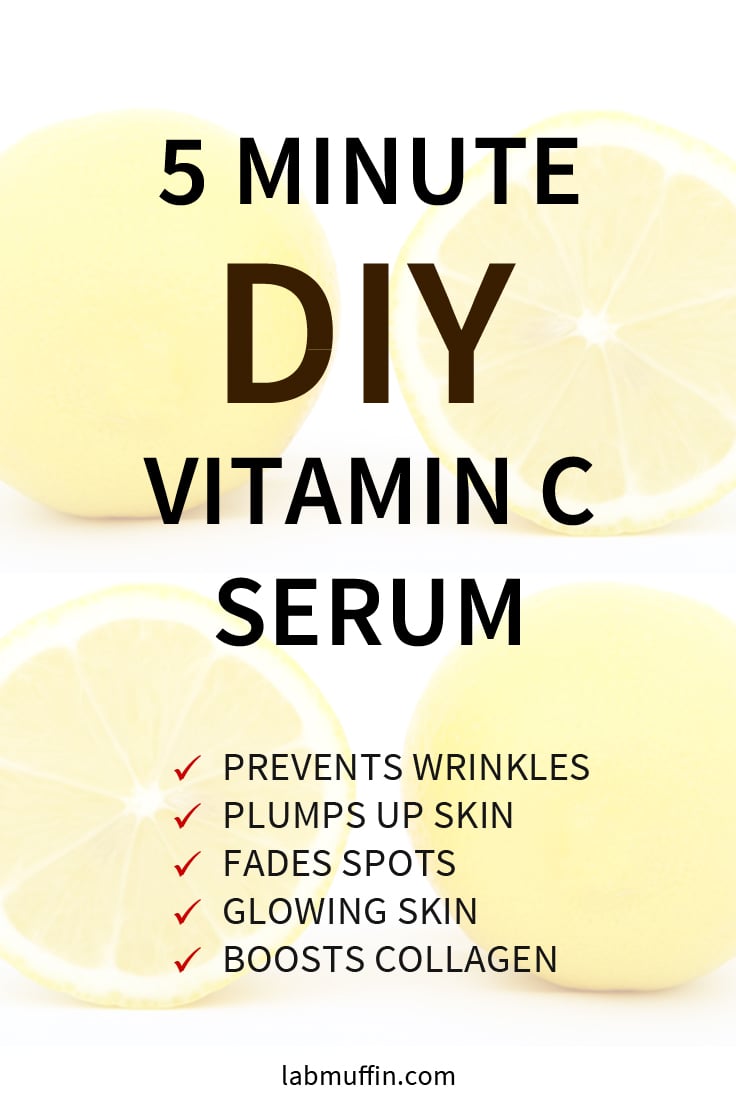
This post contains affiliate links – if you decide to click through and support Lab Muffin financially (at no extra cost to you), thank you! For more information, see Disclosure Policy.
How to Get Rid of Muffin Top in 30 Days
Source: https://labmuffin.com/easy-5-minute-diy-vitamin-c-serum-recipe/